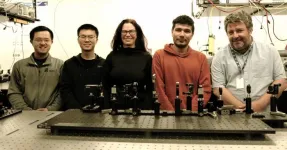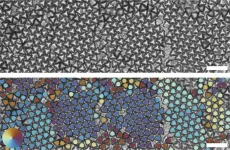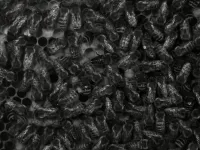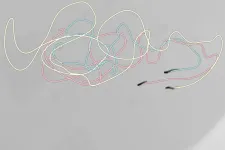(Press-News.org) Professor Jinyang Liang’s team is advancing in imaging speed with a new ultrafast camera system.
Pushing for a higher speed isn’t just for athletes. Researchers, too, can achieve such feats with their discoveries. This is the case for Jinyang Liang, Professor at the Institut national de la recherche scientifique (INRS), and his team, whose research results have recently been published in Nature Communications.
The group based at INRS’ Énergie Matériaux Télécommunications Research Centre has developed a new ultrafast camera system that can capture up to 156.3 trillion frames per second with astonishing precision. For the first time, 2D optical imaging of ultrafast demagnetization in a single shot is possible. This new device called SCARF (for swept-coded aperture real-time femtophotography) can capture transient absorption in a semiconductor and ultrafast demagnetization of a metal alloy. This new method will help push forward the frontiers of knowledge in a wide range of fields, including modern physics, biology, chemistry, materials science, and engineering.
Improving on past advances
Professor Liang is known around the world as a pioneer of ultrafast imaging. Already, in 2018, he was the principal developer of a major breakthrough in the field, which laid the groundwork for the development of SCARF.
Until now, ultrafast camera systems have mainly used an approach involving sequentially capturing frames one by one. They would acquire data through brief, repeated measurements, then put everything together to create a movie that reconstructed the observed movement.
“However, this approach can only be applied to inert samples or to phenomena that happen the exact same way each time. Fragile samples, not to mention non-repeatable phenomena or phenomena with ultrafast speeds, cannot be observed with this method.”
Professor Jinyang Liang, expert in ultra-fast and biophotonic imaging
“For example, phenomena such as femtosecond laser ablation, shock-wave interaction with living cells, and optical chaos cannot be studied this way,” explains Jinyang Liang.
The first tool developed by Professor Liang helped fill this gap. The T-CUP (Trillion-frame-per-second compressed ultrafast photography) system was based on passive femtosecond imaging capable of acquiring ten trillion (1013) frames per second. This was a major first step towards ultrafast, single-shot real-time imaging.
Yet challenges still remained.
“Many systems based on compressed ultrafast photography have to cope with degraded data quality and have to trade the sequence depth of the field of view. These limitations are attributable to the operating principle, which requires simultaneously shearing the scene and the coded aperture.”
Miguel Marquez, postdoctoral fellow and co-first author of the study
SCARF overcomes these challenges. Its imaging modality enables ultrafast sweeping of a static coded aperture while not shearing the ultrafast phenomenon. This provides full-sequence encoding rates of up to 156.3 THz to individual pixels on a camera with a charge-coupled device (CCD). These results can be obtained in a single shot at tunable frame rates and spatial scales in both reflection and transmission modes.
A range of applications
SCARF makes it possible to observe unique phenomena that are ultrafast, non-repeatable, or difficult to reproduce, such as shock wave mechanics in living cells or matter. These advances could potentially be used to develop better pharmaceutics and medical treatments.
What’s more, SCARF promises very appealing economic spin-offs. Two companies, Axis Photonique and Few-Cycle, are already working with Professor Liang’s team to produce a marketable version of their patent-pending discovery. This represents a great opportunity for Quebec to strengthen its already enviable position as a leader in photonics.
The work was carried out in the Advanced Laser Light Source (ALLS) Laboratory in collaboration with Professor François Légaré, Director of the Énergie Matériaux Télécommunications Research Centre, and international colleagues Michel Hehn, Stéphane Mangin and Grégory Malinowski of the Institut Jean Lamour at the Université de Lorraine (France) and Zhengyan Li of Huazhong University of Science and Technology (China).
About the paper
Liu, J.; Marquez, M.; Lai, Y. et al. Swept coded aperture real-time femtophotography. Nat Commun 15, 1589 (2024). https://doi.org/10.1038/s41467-024-45820-z
This research was funded by the Natural Sciences and Engineering Research Council of Canada, the Canada Research Chairs Program, the Canada Foundation for Innovation, the Ministère de l’Économie et de l’Innovation du Québec, the Canadian Cancer Society, the Government of Canada’s New Frontiers in Research Fund, as well as the Fonds de recherche du Québec–Nature et Technologies and the Fonds de recherche du Québec –Santé.
END
Pushing back the limits of optical imaging by processing trillions of frames per second
Canadian research team is advancing in imaging speed with a new ultrafast camera system
2024-03-25
ELSE PRESS RELEASES FROM THIS DATE:
Patient recovery after surgery for esophageal cancer isn’t influenced by using standard or keyhole incisions
2024-03-25
New research has found no evidence of a difference between recovery time and complications when comparing standard and keyhole surgical incisions for the treatment of oesophageal cancer (cancer of the gullet). The study, led by the University of Bristol Medical School and published in the British Journal of Surgery, showed surgeons treating patients with oesophageal cancer do not need to change their practice if they have a strong preference for either procedure type.
Oesophageal cancer is the tenth most common cancer globally. It causes one in 18 cancer-related deaths. ...
COVID-19 pandemic has left an enduring imprint on colorectal cancer surgery
2024-03-25
Key Takeaways
In a retrospective analysis of 105,517 patients with colorectal cancer, researchers found that colorectal cancer surgical cases fell by 17.3% during the first year of the pandemic.
Patients who underwent surgery for colorectal cancer in 2020 displayed more advanced stages of cancer compared to those treated in 2019.
The authors attribute these findings to multiple factors, including delays in screening, fear of COVID-19 exposure that may have prevented some people from seeking care, and disparities in cancer care that were likely exacerbated during the pandemic.
CHICAGO: While the COVID-19 pandemic is no longer considered a public ...
Elusive 3D printed nanoparticles could lead to new shapeshifting materials
2024-03-25
In nanomaterials, shape is destiny. That is, the geometry of the particle in the material defines the physical characteristics of the resulting material.
“A crystal made of nano-ball bearings will arrange themselves differently than a crystal made of nano-dice and these arrangements will produce very different physical properties,” said Wendy Gu, an assistant professor of mechanical engineering at Stanford University, introducing her latest paper which appears in the journal Nature Communications. “We’ve used a 3D nanoprinting technique to produce one of the most promising ...
Bees use antennae to decode hive mates’ dances in the dark
2024-03-25
Scientists have discovered how honeybees can decipher dances by their hive mates that relay directions to food.
The findings reveal how, in the complete darkness of the hive, each bee uses its antennae to help interpret the information communicated through the dances.
It has been known for decades that honeybees do so-called waggle dances, in which their movements and orientation on the honeycomb signal the direction and distance to food outside the hive. However, until now, it was unclear how the bees gathered around a waggle dancer make sense of the information.
Gaining greater insights into how bees communicate could help scientists to better understand the effects of ...
Nucleus Genomics launches to bring whole-genome sequencing to the public
2024-03-25
Nucleus Genomics, the next-generation genetic testing and analysis company, today announced the launch of its DNA analysis product to bring the benefits of personalized medicine to everyone.
DNA and health are inextricably linked, but profound insights into how DNA can shape health are missing from healthcare. Customers who’ve previously done microarray genetic testing with older testing companies can upload their DNA data onto Nucleus’ platform to receive greater insights into their genetic risk for diseases like type 2 diabetes, breast cancer, and many more. Nucleus further personalizes these risk assessments by integrating personal ...
How many fish constitute a school?
2024-03-25
Physicists are also interested in fish – above all when they are researching the formation of structures. A research team from Heinrich Heine University Düsseldorf (HHU) and the University of Bristol (United Kingdom) has examined the schooling behaviour of zebra danio (Danio rerio, also known as “zebrafish”) using methods from the field of multi-particle physics. In the scientific journal Nature Communications, they explain that groups of just three fish already move in a similar way to large schools while, by contrast, two fish display completely ...
Provision of medications for self-managed abortion before and after the Dobbs v Jackson Women’s Health Organization decision
2024-03-25
About The Study: Provision of medications for self-managed abortions increased in the six months following the Dobbs v Jackson Women’s Health Organization decision. Results suggest that a substantial number of abortion seekers accessed services despite the implementation of state-level bans and restrictions.
Authors: Abigail R. A. Aiken, Ph.D., of the University of Texas at Austin, is the corresponding author.
To access the embargoed study: Visit our For The Media website at this link https://media.jamanetwork.com/
(doi:10.1001/jama.2024.4266)
Editor’s Note: Please see the article for additional information, ...
Common household chemicals pose new threat to brain health
2024-03-25
CLEVELAND—A team of researchers from the Case Western Reserve University School of Medicine has provided fresh insight into the dangers some common household chemicals pose to brain health. They suggest that chemicals found in a wide range of items, from furniture to hair products, may be linked to neurological diseases like multiple sclerosis and autism spectrum disorders.
Neurological problems impact millions of people, but only a fraction of cases can be attributed to genetics alone, indicating that unknown environmental factors are important contributors to neurological disease.
The new study ...
Unlocking quantum computing power: automated protocol design for quantum advantage
2024-03-25
Imagine a world where complex calculations that currently take months for our best supercomputers to crack could be performed in a matter of minutes. Quantum computing is revolutionizing our digital world. In a research article published Feb. 19 in Intelligent Computing, researchers unveiled an automated protocol-design approach that could unlock the computational power of quantum devices sooner than we imagined.
Quantum computational advantage represents a critical milestone in the development of quantum technologies. It signifies the ability of quantum computers to outperform classical supercomputers in certain tasks. Achieving ...
Pitt receives NIH grants to study health effects of chemical exposures following the East Palestine train derailment
2024-03-25
PITTSBURGH – The University of Pittsburgh has received a pair of two-year grants from the National Institutes of Health to support studies on the health effects of environmental contamination resulting from the train derailment that spilled hazardous materials into the local communities in East Palestine, Ohio, in February 2023.
The grants, totaling nearly $1 million, were awarded through a National Institute of Environmental Health Sciences ...
LAST 30 PRESS RELEASES:
Scalable and healable gradient textiles for multi‑scenario radiative cooling via bicomponent blow spinning
Research shows informed traders never let a good climate crisis go to waste
Intelligent XGBoost framework enhances asphalt pavement skid resistance assessment
Dual-function biomaterials for postoperative osteosarcoma: Tumor suppression and bone regeneration
New framework reveals where transport emissions concentrate in Singapore
NTP-enhanced lattice oxygen activation in Ce-Co catalysts for low-temperature soot combustion
Synergistic interface engineering in Cu-Zn-Ce catalysts for efficient CO2 hydrogenation to methanol
COVID-19 leaves a lasting mark on the human brain
Scientists use ultrasound to soften and treat cancer tumors without damaging healthy tissue
Community swimming program for Black youth boosts skills, sense of belonging, study finds
Specific depressive symptoms in midlife linked to increased dementia risk
An ‘illuminating’ design sheds light on cholesterol
Who is more likely to get long COVID?
Study showcases resilience and rapid growth of “living rocks”
Naval Research Lab diver earns Office of Naval Research 2025 Sailor of the Year
New Mayo-led study establishes practical definition for rapidly progressive dementia
Fossil fuel industry’s “climate false solutions” reinforce its power and aggravate environmental injustice
Researchers reveal bias in a widely used measure of algorithm performance
Alcohol causes cancer. A study from IOCB Prague confirms damage to DNA and shows how cells defend against it
Hidden viruses in wastewater treatment may shape public health risks, study finds
Unlock the power of nature: how biomass can transform climate mitigation
Biochar reshapes hidden soil microbes that capture carbon dioxide in farmland
Reducing saturated fat intake shows mortality benefit, but only in high-risk individuals
Manta rays create mobile ecosystems, study finds
Study: Mixed results in using lipoic acid to treat progressive multiple sclerosis
Norbert Holtkamp appointed director of Fermi National Accelerator Laboratory
New agentic AI platform accelerates advanced optics design
Biologists discover neurons use physical signals — not electricity — to stabilize communication
Researchers discover that a hormone can access the brain by hitchhiking
University of Oklahoma researcher awarded funding to pursue AI-powered material design
[Press-News.org] Pushing back the limits of optical imaging by processing trillions of frames per secondCanadian research team is advancing in imaging speed with a new ultrafast camera system







